#LiDarsensors
Explore tagged Tumblr posts
Text
Software-Defined Vehicle
April 9, 2024
by dorleco
with no comment
Others

Introduction
The automobile sector has been at the forefront of creative technology adoption as it continues to evolve in response to constantly shifting consumer needs. In addition, the automobile industry’s faster time-to-market for new technologies has made it possible for this sector to conduct a lot more research and development than others.
The use of software in current cars results from the development of artificial intelligence, high-speed communication and networking, and digital product engineering. Because of this, software has become more and more crucial in enabling advancements in performance features, safety, and security to provide unique driving experiences.
Megatrends including electrification, mobility, connection, and autonomous driving are expected to transform the automotive industry over the next ten years drastically. These developments are a major factor in the automotive industry’s shift to a software-centric strategy for meeting specialized needs.
When combined, these developments can potentially cause significant disruption to the automotive sector, as each is equally potent on its own. Several other terms for this industry development include CASE-connected, automated, shared, and electrified.
The three key factors influencing technology adoption in the automotive industry are mostly responsible for these recent developments in the sector:
The updated OEM requirements
Hardware and software standardization
The vehicle described by the software
What is a software-defined vehicle?
A vehicle whose primary means of operation is software is referred to as a “software-defined vehicle.” An F-35 fighter jet contains 25 million lines of code, but a luxury automobile nowadays has about 100 million.
And a space shuttle, too! This degree of sophistication is mostly attributable to cars having an increasing number of VCUs, sensors, cameras, radar, and lidar devices.
Research conducted by Accenture predicts that by 2030, software will make up 40% of a car’s overall worth. By contrast, in 2015, this percentage was only 10%. The software tsunami is being driven by features like ADAS, over-the-air (OTA) updates, cyber security, and several new services.
To handle the potentially over 300 million lines of code that a fully autonomous automobile of the near future may have, automakers and Tier 1s are turning more and more to automotive software providers.
One of the main causes pushing toward a software-defined vehicle is the growing explosion of OEM requirements for new vehicle programs. Manufacturers now concentrate on software-enabled features that benefit the customer and help them position their product in a market that is all its own.
An advance in E/E architectures that can match simplicity and capacity is being brought about by these constantly growing software needs. This necessitates the separation of software and standardization of hardware.

Advantages, difficulties, and opportunities
Recalls relating to automotive software have been increasing. Currently, automakers notify customers through letters or emails about recalls. Customers must then drive to the dealership to manually update their software. Customers will be able to obtain updates over-the-air (OTA) in software-defined automobiles, similar to what we get on our smartphones! Along with telematics and infotainment enhancements, this technology can also monitor and adjust the powertrain and vehicle dynamics.
Custom driver experiences will be offered by the software-defined car. Huge volumes of data will be exchanged between the VCUs and DCUs and sensors and actuators, giving automakers insights unique to each car. As a result, OEMs may be able to create a new source of income in addition to strengthening their relationship with customers.
Adopting software-centric methodologies also comes with some corporate and cultural obstacles. Reworking their supply chain connections and business models will be necessary for OEMs and Tier 1s. The automobile industry will need to upskill to implement new software tools and procedures.
For new software features to be developed and deployed effectively, the project roadmap needs to be managed more carefully and in a way that offers value.
Increased software equals increased potential for cyberattacks. An attacker can gain access to a vehicle’s systems through Wi-Fi, Bluetooth, cellular networks, and other means from anywhere on the globe.

Thus, protecting systems against such attacks requires creative solutions and reliable methods.
Since more cyber security regulations are being driven by high-security requirements, which will ultimately enhance the system, we should be able to take advantage of many more possibilities that may be present in the problems. To create software for their next car programs, OEMs must make important strategic choices. If OEMs choose to create in-house software to satisfy demands across domains, they have the opportunity to become software giants.
It’s also an option for OEMs to choose to build only a portion of the highly distinguishing domains in-house while outsourcing the other software needs.

Alternatively, they have the option to fully contract out all of their software development and services to specialist software vendors.
The software capabilities of the car of the future and its capacity to live up to expectations obtained from traditional software platforms will determine it to a large degree. The effective integration of major technology suppliers and new industry participants will open up new opportunities for the software-defined future!
This makes it possible for numerous up-and-coming automotive software technology businesses, such as Dorleco, to enter the market and establish themselves by collaborating with significant OEMs and Tier 1s. Are you trying to find a complete software package for your upcoming smart car? Send an email to [email protected] to find out more about our assistance.
#VCUs#VehicleControlUnit#softwaredefined#LiDarsensors#Autonomousvehicle#VCUSupplier#VCUManufacturer#Dorleco
0 notes
Text
Automotive LIDAR Security Market Set for Explosive Growth, Reaching $15.2B by 2034
Automotive LIDAR Security Market is accelerating fast, powered by the rise of autonomous vehicles and demand for advanced safety features. LIDAR (Light Detection and Ranging) plays a pivotal role in enabling real-time 3D mapping, object detection, and collision avoidance — core components of ADAS and self-driving systems.
To Request Sample Report : https://www.globalinsightservices.com/request-sample/?id=GIS33030 &utm_source=SnehaPatil&utm_medium=Article
Solid-state LIDAR leads the market due to its affordability, durability, and seamless integration into modern vehicle designs. Mechanical LIDAR holds the second spot, prized for its precision in mapping and navigation. North America dominates this space, driven by heavy investments and a strong regulatory push for autonomous vehicle development. Europe closely follows, with countries like Germany spearheading innovation.
Industry leaders such as Velodyne, Innoviz Technologies, and Luminar Technologies are shaping the market with cutting-edge tech — improving resolution, reducing costs, and optimizing integration. Applications stretch beyond just vehicles, impacting traffic management and smart city infrastructure.
As AI and machine learning continue to enhance LIDAR’s functionality, the market outlook is strong. Challenges like high costs and complex integration persist, but ongoing innovations are paving the way for widespread adoption and smarter, safer mobility.
#lidar #automotive #autonomousvehicles #adas #vehiclesafety #lidartechnology #solidstatelidar #mechanicallidar #hybridlidar #3dmapping #objectdetection #collisionavoidance #smartmobility #aiintransport #machinelearning #smartcars #vehicletech #lidarsensors #velodyne #innoviz #luminar #futureofdriving #autonomousmobility #smartcities #connectedcars #regtech #transporttech #mobilitysolutions #sensorfusion #automotiveinnovation #selfdrivingtech #vehiclenavigation #techdriven #oemtech #automotiveelectronics #lidarsecurity
0 notes
Text
LIDAR in Space? This Market is Shooting Up to $3.5B by 2034!
LIDAR for Space Exploration Market is rapidly evolving, driven by cutting-edge remote sensing technologies designed for planetary mapping, asteroid detection, and spacecraft navigation. By 2034, this market is set for substantial expansion, fueled by increased space missions and advancements in AI-driven analytics.
To Request Sample Report : https://www.globalinsightservices.com/request-sample/?id=GIS33018 &utm_source=SnehaPatil&utm_medium=Linkedin
🔍 Market Overview LIDAR technology plays a pivotal role in topographical data collection, supporting autonomous operations on celestial bodies. The space-based LIDAR segment leads the market, primarily used for planetary mapping and surface analysis. Ground-based LIDAR systems follow closely, aiding in satellite calibration and atmospheric research.
🌍 Regional Insights North America dominates the market, benefiting from heavy investments in space exploration and a strong presence of key industry players. Europe ranks second, driven by collaborative space missions and technological innovations. Countries such as the United States and Germany spearhead advancements, enhancing LIDAR applications in interplanetary exploration.
📊 Market Segmentation
Type: Airborne, Terrestrial, Spaceborne, Mobile, Static
Technology: Time-of-Flight, Phase Shift, Waveform LIDAR
Application: Planetary Mapping, Asteroid Detection, Satellite Altimetry, Spacecraft Landing Assistance, Atmospheric Monitoring
End Users: Space Agencies, Research Institutes, Commercial Space Companies, Defense Organizations
🚀 Future Outlook The terrestrial LIDAR segment dominates, while airborne LIDAR follows at 35%. Spaceborne LIDAR is gaining momentum, with emerging applications in satellite technology and asteroid mapping. Leading players like Teledyne Optech, Velodyne Lidar, and Leica Geosystems continue to drive innovation. Despite challenges in cost and technical complexity, rising investments and AI-driven enhancements promise substantial market growth.
#lidar #spaceexploration #spacetechnology #remotesensing #lidartechnology #nasa #esa #spacedata #planetaryscience #satellitetechnology #interplanetaryexploration #aiinspace #spacemissions #asteroidmapping #futuretech #deeptech #lidarforgood #spacerevolution #newspace #autonomousnavigation #3dmapping #spacex #martianexploration #moonmissions #aiinnovation #geospatialdata #spaceresearch #commercialspace #lidarsensors #earthobservation #militarytech #defensetechnology #innovation #nextgentechnology #nasatech
Research Scope:
· Estimates and forecast the overall market size for the total market, across type, application, and region
· Detailed information and key takeaways on qualitative and quantitative trends, dynamics, business framework, competitive landscape, and company profiling
· Identify factors influencing market growth and challenges, opportunities, drivers, and restraints
· Identify factors that could limit company participation in identified international markets to help properly calibrate market share expectations and growth rates
· Trace and evaluate key development strategies like acquisitions, product launches, mergers, collaborations, business expansions, agreements, partnerships, and R&D activities
About Us:
Global Insight Services (GIS) is a leading multi-industry market research firm headquartered in Delaware, US. We are committed to providing our clients with highest quality data, analysis, and tools to meet all their market research needs. With GIS, you can be assured of the quality of the deliverables, robust & transparent research methodology, and superior service.
Contact Us:
Global Insight Services LLC 16192, Coastal Highway, Lewes DE 19958 E-mail: [email protected] Phone: +1–833–761–1700 Website: https://www.globalinsightservices.com/
0 notes
Text
What is the European market view on 4D Lidar Sensor Technology?
What is the European market view on 4D Lidar Sensor Technology? #LidarSensor #Technology #AutonomusVehicles
A rapid adoption of Lidar sensor technology can be seen in Europe, especially for autonomous vehicles. The demand is high in the initial stages of testing and developing 4D Lidar sensors. Significant investments can be seen in European companies and research institutes in 4D lidar services that provide 3D spatial measurements as well as velocity data by measuring the Doppler frequency shift of…

View On WordPress
0 notes
Link
Rapid developments in autonomous vehicle technology coupled with the growing deployment of continuous-wave frequency modulation will drive the global automotive LIDAR Sensors Market to register a CAGR of 47% during 2018-2022.
0 notes
Photo

@wreckersupplyus: Exclusive: Apple in talks with potential suppliers of sensors for... https://t.co/doNlhvinza #driverless #autonomous #Apple #driving #lidarsensors #selfdriving
0 notes
Video
Autonomous buses: that will transport students from the University of Michigan.
The University of Michigan also shows that it competes, albeit in a different way. The north campus of this University, known as MCity, is renowned for various developments in autonomous systems and has now put into practice its knowledge to give life to its first autonomous transport system in which its students will travel...
#Autonomousbuses #Autonomous #buses #UniversityofMichigan #MCity #LIDARsensors #Abantech #cameras #GPS #WiFiconnection
0 notes
Text
Steer-By-Wire
April 9, 2024
by dorleco
with no comment
Autonomous Vehicle Technology
Edit
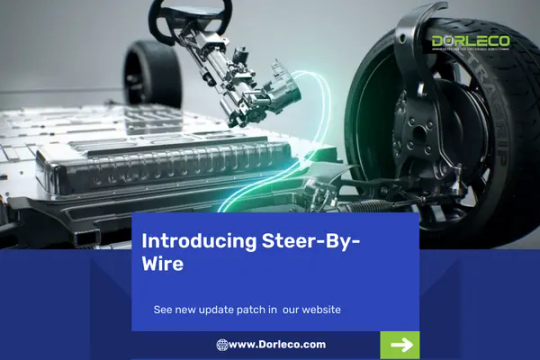
Introduction
The automotive industry has proposed the idea of “smart vehicles” multiple times in recent years. This idea is defined differently by each vehicle designer, with the majority of attention going toward process automation to obtain a quicker reaction. Along with sensors and actuators, this also entails substituting electrical signals for mechanical connections and linkages. Among these novel elements is the steer-by-wire technology.
1. How a steer-by-wire system operates:
A steer-by-wire system, as you may have guessed with some accuracy, effectively substitutes the mechanical linkages with electronic connections between the steering wheel and steering rack, or the steering column.
The steering wheel position sensor gauges the driver’s desired steering angle and relays this information to the control unit, which directs the steering actuator to make the turn. The required steering torque is produced by another actuator on the steering wheel, giving the driver a realistic feel.
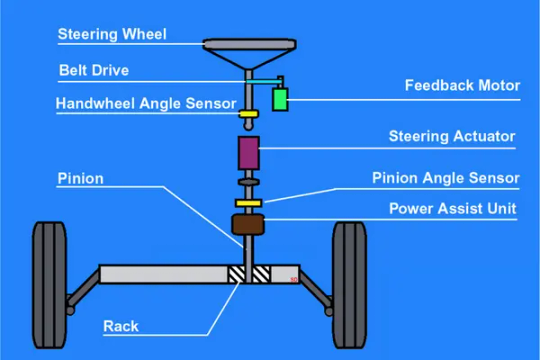
2. Benefits of steer-by-wire technology include:
The weight savings resulting from the steer-by-wire system’s fewer mechanical components is one of its clear benefits. This style of design also lessens general wear and tear and enhances maintenance capacity. Since there are no restrictions on where the steering wheel can be placed, it also makes more design alternatives possible.
Additionally, it is not necessary to build different steering systems for cars with left- and right-hand drives. As a result of noise and vibrations not being directly transferred, the car’s cockpit has a better acoustic design.
3. Steer-by-wire fail-safe mechanisms:
Even a steer-by-wire system needs some redundant systems that can take over in the event of a malfunction, just like any other x-by-wire system does. Frequently, a second steering motor is added to the arrangement so that it can take over if the primary motor loses signal strength. Controlling the amount of driving force applied to the front wheels, which would produce a steering effect, is another intriguing idea.

4. Design enhancements and optimizations:
The way the driver receives steering feedback when turning the car might be improved. The steering “feel” in a traditional steering system is limited by the steering system’s mechanics.
Nonetheless, there is a great deal of room for enhancement and optimization because the steer-by-wire system lacks any physical connections that would limit the steering feedback.
This entails giving the steering wheel additional configuration options. Software-based solutions for enhancing the feel can help reduce the amount of time needed to fine-tune it.
Using Road feedback can also help maximize the steering feel. While a typical steer-by-wire system won’t reflect any bumps to the steering wheel, some automakers attempt to use this input to enhance the ride quality of the steering wheel.
One major benefit of this type of design is that it is easy to modify the amplitude of road feedback, which allows automakers to adjust the feedback’s intensity to match the driving mode that is being chosen. (For instance, under “comfort” mode, these bumps on the road will be muted.)
Another design adjustment made possible by the steer-by-wire technology is the virtual steering ratio. The steering is solely limited by the chassis and the tuning of the vehicle reaction because there is no mechanical linkage.
Extreme rack configurations can also be simulated by varying the steering ratio, which increases the vehicle’s agility and controllability. The steering ratio is defined as the ratio of the number of degrees the steering wheel turns to the number of degrees the wheel(s) result in.
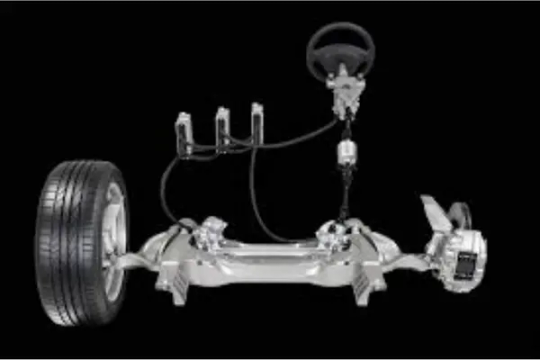
Moreover, a steering angle offset can be applied using a virtual steering ratio. This contributes to the vehicle’s increased steering stability. This can be accomplished by utilizing a steering stability assist, which uses a superimposed steering angle to stabilize the car based on input from the driver, or a steering stability controller, which adjusts the vehicle’s yaw rate to match a pre-set model.
Both are practically undetectable active safety elements that can improve the vehicle’s stability. In the event of an unusual detour from the road, they can react quicker than a human and aid in reducing the effects of steering instability.
5. Steer by Wire Controls Development at Dorleco:
Therefore, a steer-by-wire system can aid in enhancing the vehicle’s reaction while also permitting design changes and enhancements that would not be feasible with a traditional steering system. It also permits more flexibility in choosing the steering wheel’s location, reduced physical component wear and tear, and improved noise and vibration damping design for vehicles.
Our job at Dorleco is to create control algorithms and provide software for steer-by-wire systems in electric and hybrid cars.
#VCUs#VehicleControlUnit#SteerByWire#LiDarsensors#Autonomousvehicle#VCUSupplier#VCUManufacturer#Dorleco
0 notes
Text
Sensors in Autonomous Vehicles
April 5, 2024
by dorleco
with no comment
Autonomous Vehicle Technology
Edit
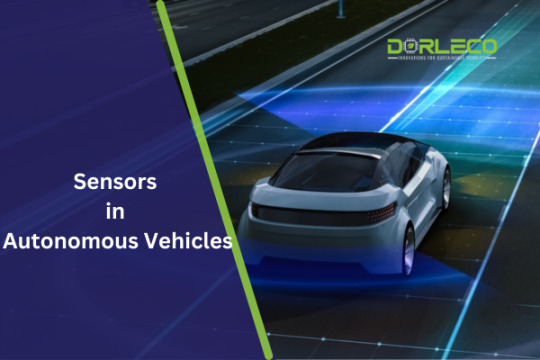
Introduction
The entire discussion on sensors in autonomous vehicles consists of one major point: will the vehicle’s brain (i.e., the computer) be able to make decisions just like a human brain does? Whether a computer can make these decisions is an altogether different topic. Still, it is just as important for an automotive company working on self-driving technology to provide the computer with the necessary and sufficient data to make decisions.
This is where sensors, particularly their integration with the computing system, come into the picture.
Sensor Types in Self-Driving Cars:
Autonomous vehicles employ three primary types of sensors to map their surroundings: radio-based (radar), vision-based (cameras), and light- and laser-based (LiDAR).

The following is a quick explanation of these three types of sensors found in autonomous vehicles:
1. Cameras
A 360° view of the vehicle’s surroundings can be obtained by installing high-resolution video cameras in various places around the body of the vehicle. They take pictures and give the information needed to recognize various items on the road, like people, traffic lights, and other cars.
The ability to precisely identify things is the primary benefit of utilizing data from high-resolution cameras, and this ability is utilized to map 3D representations of the environment around the vehicle. However, in bad weather—such as at night or during periods of intense rain or fog—these cameras don’t function as precisely.
Sensors based on vision that are used:
Monocular vision sensor one-sided vision One camera is used by sensors in autonomous vehicles to assist in the detection of moving objects, such as pedestrians and cars. This system will only detect categorized things because it mostly depends on object classification. By simulating millions of kilometers of travel, these algorithms may be trained to identify and categorize items. It identifies items by comparing their sizes to those that are recorded in its memory. As an illustration, suppose that an object is identified by the system as a truck. The technology may compare the size of the new truck with the size of the old truck and determine the distance based on this information. On the other hand, an object that the system is unable to classify will remain unnoticed. Developers of autonomous systems are quite concerned about this.
Stereo vision sensorA dual-camera arrangement seen in a stereo vision system aids in precisely estimating the distance to an object even when the system is unable to identify what it is. The device serves as a human eye and aids in determining an object’s depth because it has two separate lenses. The system can use triangulation to determine the distance between the object and the camera because the two lenses record slightly different images.

Radar Sensors for Self-Driving Cars Autonomous vehicles equipped with radar sensors employ radio waves to scan their surroundings and determine the precise size, angle, and velocity of objects. The object’s size, velocity, and distance from the host vehicle are all determined by the sensor, which emits radio waves through a transmitter inside and measures how long it takes for the waves to be reflected.Radar sensors have been employed in ocean navigation and weather forecasting in the past. This is because it outperforms vision-based sensors due to its very consistent performance under a wide range of weather conditions.
One way to categorize RADAR sensors is by their operational distance ranges:
The main benefit of short-range radar (SRR) sensors is that they can detect pictures with a high degree of resolution, covering a range of 0.2 to 30 meters.
This is crucial since, at low resolutions, it might not be possible to identify a pedestrian who is in front of a larger item.
MRR (Medium Range Radar): 30 to 80 meters Long-Range Radar (LRR): (80m to more than 200m) These sensors work well with highway Automatic Emergency Braking (AEB) and Adaptive Cruise Control (ACC) systems.
2. LiDAR sensors
There are certain advantages of LiDAR (Light Detection and Ranging) over radar and vision-based sensors. It sends out thousands of fast-moving laser light waves, and when those waves are reflected, they provide a far more precise impression of the size, distance, and other characteristics of a vehicle. Numerous pulses produce unique point clouds, which are collections of points in three dimensions; hence, a LiDAR sensor may also provide a three-dimensional image of an object.
LiDAR sensors frequently have excellent precision when detecting small objects, which enhances object identification accuracy. Furthermore, LiDAR sensors can be set up to provide a 360° view of the surroundings of the car, negating the need for several identical sensors.
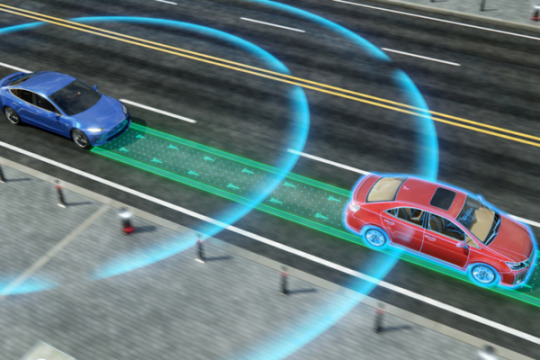
The disadvantage is that LiDAR sensors have a complicated architecture and design, which means that adding one to a car can result in a multiplication of manufacturing costs. Furthermore, the high processing power requirements of these sensors make it challenging to combine them into a small design. The majority of LiDAR sensors operate at 905 nm, which allows for precise data collection in a limited field of view up to 200 m.
A few businesses are also developing 1550 nm LiDAR sensors, which will be even more accurate over a greater distance.
3. Ultrasonic Sensors
The majority of uses for ultrasonic sensors in autonomous vehicles occur in low-speed driving scenarios. Ultrasonic sensors are found in the majority of parking assist systems because they can accurately measure the distance between an object and a car, regardless of the object’s size or shape.
The transmitter-receiver configuration makes up the ultrasonic sensor. The ultrasonic sound waves are sent by the transmitter, and the distance to the obstacle is computed from the time interval between the wave’s transmission and reception.
Ultrasonic sensors have a precise distance measurement range of a few millimeters to five meters. Additionally, they can detect objects at very close range from the car, which can be quite useful when parking. Additionally, ultrasonic sensors can be utilized to identify environmental factors and facilitate vehicle-to-vehicle (V2V) and vehicle-to-infrastructure (V2I) communication. Sensor data from thousands of these networked cars provides reference data for various situations, conditions, and places, and can aid in the development of algorithms for autonomous vehicles.
4. Filtering Out Noise
Unwanted noise or interference in the surroundings is the primary source of uncertainty created by the use of individual sensors. Naturally, every piece of data that is detected by a sensor in the environment is made up of two parts: the noise, which we want to ignore, and the signal, which we require.
However, the uncertainty comes from not knowing how much noise there is in any given set of data. Generally speaking, high-frequency noise can lead to significant distortions in sensor data. Such high-frequency noise must be eliminated if we are to have the most precise signal possible. Linear (like the simple moving average) and non-linear (like the median) filters are the two categories of noise filters.

The noise filters that are most often utilized include:
A low-pass filter attenuates signals that are greater than the cut-off frequency while passing signals that have frequencies lower than the cut-off.
A high-pass filter attenuates signals that are lower than the cut-off frequency while passing signals that are higher than that cut-off frequency.
The Kalman filter, recursive least squares (RLS), and least mean square error (LMS) are a few other popular filters.
Development of Autonomous Vehicle Features at Dorle Controls
Our goal at Dorle Controls is to offer customized software development and integration services for self-driving cars as well. This covers both creating specific applications depending on user needs and creating the full software stack for an autonomous car.
To learn more about our skills in this field, send an email to [email protected].
#VCUs#VehicleControlUnit#sensors#LiDarsensors#Radarsensors#Autonomousvehicle#VCUSupplier#VCUManufacturer#Dorleco
0 notes
Text
Which are the top Lidar sensor companies?
Which are the top Lidar sensor companies? #LidarSensor #SensorTechnology #AutonomousVehicle
The companies based on top Lidar sensors are:- Velodyne Lidar was founded in 1983 and is considered one of the pioneers in 3D lidar sensor technology. The company is involved in a wide variety of sensors used especially in automotive, mapping, industrial automation, and more. Luminar was founded in 2012 and is mainly based on affordable high-performance Lidar for automotive applications. The…
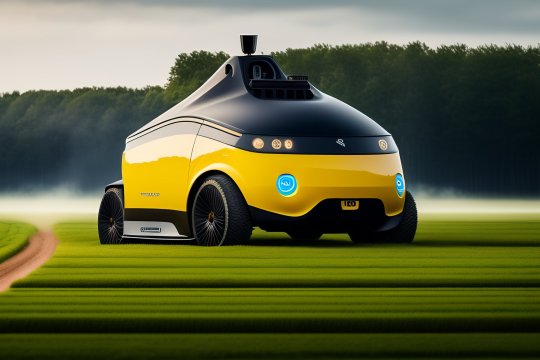
View On WordPress
0 notes